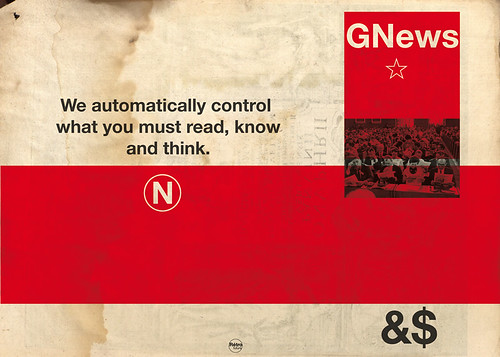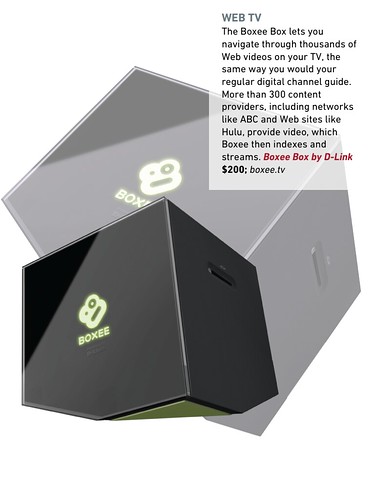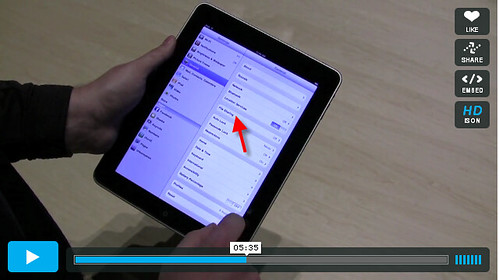Starting my day the right way
Always good to be on the road
@boxee in @popsci+ on the iPad
I noticed that Popular Science had published for iPad using the Mag+ system and decided to download an issue. So far it’s pretty cool. As you can hopefully tell from the enclosed screenshot, the design is quite clean and very high resolution. It’s not as natural a reading experience as i would have hoped and there’s almost a forced amount of touch to reveal the copy at times, but i still like how this works.
How to effectively kill personalization in your marketing campaign
Having a great start to the day
Google news We automatically control what you must read, know and think.

Google news We automatically control what you must read, know and think., originally uploaded by Rétrofuturs (Hulk4598) / Stéphane Massa-Bidal.
Very cool set on Flickr … More here
The post-iPad digital home
I’ve been thinking about the potential impact the iPad will make on my home and there’s a natural progression for a certain hobby of Apple’s which of course is AppleTV.
If the iPad succeeds at becoming the predominant home use system as I believe it easily can, it could really be an “instead of” not an “in addition to” sort of thing. Let me explain …
Apple is positioning the iPad as a third device category which it definitely is as they’ve laid out the initial plan. Once it arrives though, the amount of time my MacBookPro is going to get at home will be quite limited. Currently the MacBookPro sits on my desk fully wired and connected to an array of devices. I’ve got 3 hard drives, a slew of USB widgets and a second monitor. Our home media collection streams via an AppleTV connected through our whole house AV system and enables music to stream anywhere and video you reach any tv. The AppleTV is the set top box and my MacBookPro is essentially serving as an overpriced NAS. When it’s time to do some photo or video processing I do need the Mac, but that’s something I do occasionally rather than daily.
The AppleTV or some revised iteration (Mac Mini home server edition?) combining network connected storage and speed could easily replace the Mac and sit on a rack in a closet hosting our personal cloud. While the AppleTV works well, it’s been restricted based on lack of attention. The iPad’s sync capability needs to be adjusted slightly to accommodate wireless sync, but as that’s already something AppleTV handles easily it should not be too challenging a change.
How might this all this all start to work together?
- When I walk into the home and connect to the network, the iPad would know to sync with my home automatically. Any media captured, files created or changed would automatically push up to the system waiting at home and the network would also push new content found (podcasts downloaded, pre-ordered new content etc) back to me keeping both sides current.
- Other iPads would also be notified and could suggest we exchange mutual files based on tags of each other (faces from iPhoto, shared playlists, calendar updates, “digital fridge notes” etc)
- While in the home, we’d be able to move media fluidly between screens. Watching a video on the TV, but want to continue it in the home office or bed? No problem, the iPad easily receives the stream and lets you continue where you left off. Music could be handled in the same way … someone wants to watch a video in the family room when you are listening to music, simply switch the stream over to the iPad.
- Apple’s Remote app for iPhone is a nice but limited suggestion on how home media control might work given the smaller screen of the iPhone. With the iPad, you really can have a substantial view and control of what’s playing across various rooms in the home.
This is of course my “limited” future vision for how these things might come together, but I think speaks to the reality we could be living in as soon as later this year.
File Sharing on the iPad?
I was just enjoying a walk-through video from iLounge and noticed an interesting new preference for File Sharing. It’s off by default, but I wonder if there’s some sort of adhoc webDAV built in so you can move files, sync and share. Very interesting …
Where’s the Gmail on Blackberry experience?
Email and PIM functions on the Blackberry are stellar. Dare I say the best actually. I’ve used a slew of mobile devices and the sheer speed with which you can cut through inbox clutter is unparalleled.
I should qualify that point by saying I use a corporate issue device running on BES, not the consumer version. When it comes to the consumer mail experience I’ve consolidated my email within Gmail and sadly that’s where I’m finding some cracks in the foundation … I can’t tell whether this is a Blackberry or Google issue, but Gmail on the Blackberry is lacking thanks to one substantial detail – there’s no IMAP.
Gmail easily pushes to my device and often arrives before the Gmail screen even has a chance to refresh. The problem is that there is no reconciliation … at all. Thanks to POP3 access I have to manage my mail in two places which I’ve been tolerating because I want my mail, but loathe.
If Facebook is tuning the ad targeting up a notch, they might want to double check their work
I’ve only competed in one triathlon, but I did discuss it there. Since, I’ve become fans of products, pros and see some of my friends also share my interest. I’ve shared plenty of workout related data and I think I even gave a thumbs up to an ad recently … That said, I can’t believe this is what I was served tonight. Just a tad over the top.
Pedaling.tv
Thanks to Bike Hugger, I just learned about Pedaling.tv which looks like it will be a very cool cycling travelogue … I’m subscribed via Vimeo! Here’a peek at the trailer …
PEDALING: NYC Trailer from Iri Greco/Panforte Productions on Vimeo.
Jolicloud Pre-Release
I’m writing this in the browser as I tend to do, though instead of running Windows or OSX, I’m using Jolicloud on my netbook. I’ve had it loaded previously, but since I hacked the system with a new wireless card (to hackintosh) it failed to work without a wired connected, severely limiting my desire to use it. Recently though Jolicloud released a more public beta and I loaded it up yesterday from Windows 7 and Jolicloud took care of everything …
A few system updates later (seems every OS has that post load) I’m really pleased with how Jolicloud runs. The metaphor is a bit different than most operating systems – for starters, you need to have a live connection to do most everything. This is great for most things, but something to really consider if you travel around as you won’t be able to do much without finding your way online.
Jolicloud runs over ubuntu from what I can tell, and while it’s linux all the geeky stuff is hidden away behind a simple interface that’s essentially just a launcher. The “apps” you load are all single window browser apps via Mozilla Prism. Just like running prism on a standard pc or Fluid on your mac, these apps look like apps when you use your task switcher, but also have the limits of just being in the browser. A few examples of minor limits are no easy way to see you’ve got new mail with Gmail or ?alerts from twitter. These are hardly deal breakers, but certainly adjustments you need to make.
I’ve encountered a few bugs (this is pre-release) which will hopefully be resolved in time for the full release.
- The first is that Prism is not maintaining my login from Firefox to the Prsim web app. I’m thinking this should work as it’s running from the same base, though perhaps I am misunderstanding how Prism utilizes the Firefox system.
- A more serious issue is that it’s impossible to use Facebook Connect to login to various sites. When I’ve clicked to use it Firefox loads from Prism and instead of redirecting back to Prism, the page load dies. This one neds to be fixed so things are considerably more fluid
Jolicloud is really a slick system. I’d definitely recommend checking it out for someone less geeky and using one of the linux based netbooks. Coming from Windows, there are going to be some adjustments (no real offline apps), but for casual computing it’s a great system.
First post … again
Over the past 24 hours, I’ve moved my site from one host to another and done a full and clean install of WordPress in the new location. It wasn’t simple and I had a few technical glitches getting all my content out and then back into WordPress, but it’s all set now and I’m quite pleased.
As a bonus, I also finally took care of removing the /wp from my URL so it’s just all at the root now which I’ve wanted to do for a long time. I found an excellent plugin to handle the 301 redirects which was something I was initially concerned about, but this plugin makes it totally painless to instantly change how things work.
I should note that the technical issues resulted from a massive volume of past posts. I’ve had this blog running in some form or another since 2002, and exporting it all via WP did not work. My mysql skills are lacking and it took a few tries dealing with phpmyadmin and tech support from both my past and now current hosts.
All good now … If you notice anything out of the ordinary, please do let me know. Otherwise, not much to see here.
The Invisible Man
>
> Lu Bo Lin ~ The Invisible Man> This guy paints himself. He uses no trick photography; he just paints
> himself.
>
>
>
>
>
>
>
>
>
>
>
Another beautiful morning!
Happy Halloween!
Symbian is open
Amazingly candid interview from Om with Lee Williams, the CEO of the Symbian Foundation.
Now it’s time to deliver.
Nokia Tries to Undo Blunders in U.S.
From The New York Times:
There is a lot of ground to make up here as anyone knows. Nokia has deep pockets and a solid range, but they just seem to be getting whacked on the high end … And so far have revealed very little to earn back this critical slice of market and importantly mindshare.The world’s biggest cellphone maker has seen its share of the U.S. market slide to 7 percent from a peak of 35 percent, but it is now trying to turn around.
http://www.nytimes.com/2009/10/19/technology/companies/19nokia.html
Apple Picking!
injinji 5 toe socks
Feel a bit strange at first and require some time to get on, but are actually very comfortable. About to go for my first run in them …


















